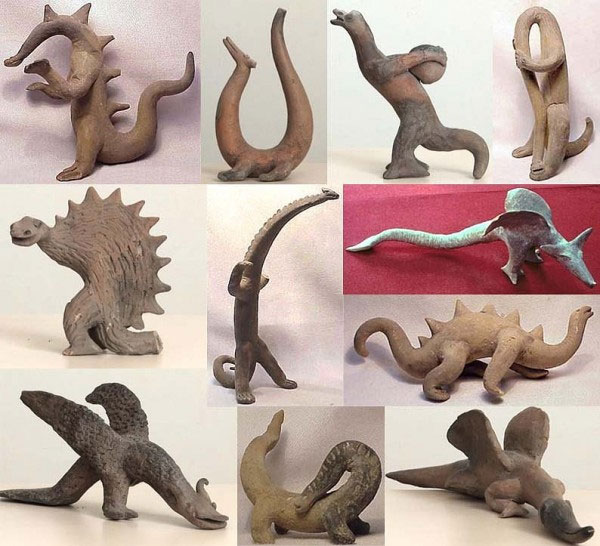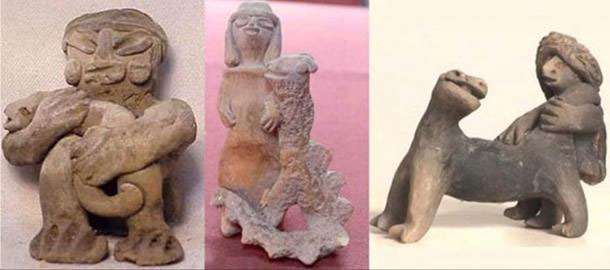Mysterious stone statues make us hypothesize: Did humans live at the same time as dinosaurs?
Most paleontologists and geologists believe that dinosaurs existed between 220 million and 65 million years ago. Meanwhile, the ancient Homo sapiens were declared to appear about 200 thousand years ago. This shows that dinosaurs and humans could not live in the same era.
However, the process of discovering archaeological sites discovered a lot of evidence that denied this view. Acambaro statues in Mexico are one such example.

Part of the 33,000 statues of Acambaro.
Collection includes 33 thousand statues
In July 1944, Waldemar Julsrud, a German merchant, stumbled upon a dinosaur-shaped statue while on his way to a mountain in the city of Acambaro (Mexico). Being an antique collector, Julsrud immediately realized the strange feature of this statue.
Julsrud then mobilized workers to conduct a large-scale search and dig around the area where the statue was discovered. This effort helped the Julsrud group unearth up to 33,000 other statues. The statues are baked from clay and largely take the shape of ancient creatures. Moreover, many statues also depict the cohabitation of humans and dinosaurs.

The statues carry dinosaurs.
Julsrud's collection immediately created an interest in archeological research. In terms of both quantity and variety, the Acambaro statue collection has been considered one of the most valuable collections in the world.
Doubtful points
The Acambaro terracotta statue is proof that supporters of the view that the dinosaurs went extinct 65 million years ago are confused. If we believe in evidence in the statues, this means that human history will have to be rewritten. Therefore, the doubts are focused on proving that the Acambaro collection is fake archaeological artifacts.
In 1956, American archaeologist Charles Di Peso set out for Mexico to confirm the true authenticity of the Acambaro statues. After analysis, Di Peso said the statues did not seem to resemble ancient artifacts.

The statues are in doubt because they still retain good quality.
According to Di Peso, most of the statues were not significantly damaged. The amount of dust clinging in the cracks is not much. Di Peso made the initial conjecture that the statues were only buried underground for about 10 years before being discovered in 1944.
To supplement the publication, Di Peso put another doubt. He said that the area of Acambaro contains very few dinosaur fossils. If humans living in Acambaro make statues, they will get reference images from where if this area does not show signs of existence of many dinosaurs.
Di Peso said that there must have been a family in Acambaro that created terracotta statues based on the images of the prehistoric monsters described in the biology books available at the Natural Museum.

The Acambaro collection also contains statues of marine creatures believed to have gone extinct tens of millions of years ago.
Rejected Di Peso's announcement
The people who deny Charles Di Peso's announcement are extremely popular. This pressure led Di Peso to conduct further analysis based on chemical testing. In the second analysis, Di Peso himself admitted that he could not determine the exact time to create the statues. From the estimate of 10 years before 1944, Di Peso made changes with the estimated age of the Acambaro statues being about 200 years old.
Not only Di Peso, many other denial studies are unable to stand up to critical views. A strong argument supporting the hypothesis that dinosaurs and humans coexist, as well as the validity of the Acambaro statue were published in 1992.
This is the year when biologists published an anatomical map of the Sauropod dinosaur. Meanwhile, an Acambaro statue from 1944 accurately depicts the shape and thorny gland of this dinosaur.

It is not simple to deduce an anatomical map of the Sauropod species.
This raises a series of questions: Did ancient humans ever see dinosaurs firsthand? How are they able to describe them correctly without analytical knowledge?
Besides, around Acambaro area, there is no record of any family having the tradition of making earthenware. To create 33 thousand statues requires a ceramic workshop of hundreds of workers for many years. Obviously such a large pottery factory will have a reputation in the cultural history of the city of Acambaro.

These 3 statues depict images of humans tamed dinosaurs. Others describe scenes of dinosaurs harming people.
In addition, a pottery factory will not produce large quantities of products just for entertainment. If produced, they would follow someone's orders. If someone paid for the massive collection of 33,000 statues, he would not have buried this precious treasure in a remote mountainous area in the early 1900s (the time of making the statues). in the opinion of the doubters).
Because of not being able to prove the true nature of the Acambaro statue, up to now, the collection of 33,000 statues is implicitly recognized as one of the most interesting mysteries of the world archeology.
- Unexpected facts about dolphins that few people know
- Climate change changes the pH of the ocean, returning to what it was 14 million years ago
- Decipher the mystery: An extremely ugly, scary monster is called a "living fossil"
- Discover the secret about the octopus - The "monster" of the sea
- Spectacular surreal scenes "dolphins glow" under the sea
FIDITOUR TRAVEL COMMUNICATION COMPANY
Representative: Mr. Tran Van Long - Chairman and General Director
Head office: 95B-97-99 Tran Hung Dao, District 1, City. Ho Chi Minh.
Hanoi Branch: 66 Tran Hung Dao, Hoan Kiem District, Hanoi
Phone: 028 730 56789 | Hotline: 19001177